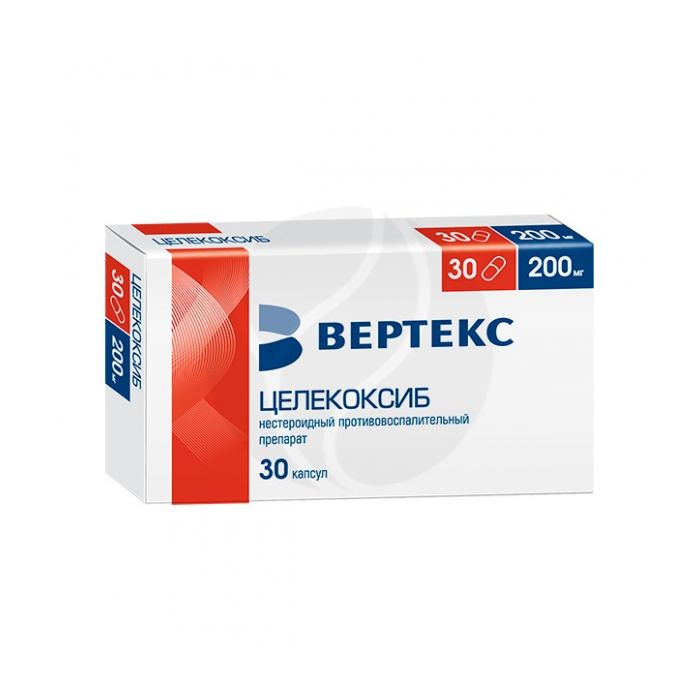Celecoxib capsules 200mg, No. 30
Expiration Date: 11/2025
Russian Pharmacy name:
Целекоксиб капсулы 200мг, №30
When administered orally for adults, the dose is 200 mg / day in 1-2 doses, if necessary - 200 mg 2 times / day.
Elderly patients weighing less than 50 kg or with moderate liver dysfunction, treatment should be started with the minimum recommended dose.
There is no clinical experience with celecoxib in patients with severe hepatic or renal impairment.
Capsules yellow, hard, gelatinous No. 0; the contents of the capsules are granular powder or compacted mass, which disintegrates when lightly pressed with a glass rod, white or almost white.
1 caps.
celecoxib 200 mg
Excipients: lactose monohydrate, sodium lauryl sulfate, povidone (K-30), croscarmellose sodium, magnesium stearate.
Severe renal dysfunction, severe liver dysfunction;
history of allergic reactions to acetylsalicylic acid or other NSAIDs, III trimester of pregnancy, lactation (breastfeeding);
hypersensitivity to sulfonamides, hypersensitivity to celecoxib.
Pharmacological action of NSAIDs.
It is a selective inhibitor of COX-2, thereby blocking the formation of inflammatory prostanoids. At therapeutic concentrations in humans, celecoxib does not inhibit COX-1; therefore, it does not affect the prostanoids synthesized by COX-1 activation. Criteria for determining specificity for COX-2 include the absence of side effects due to the action of COX-1, especially gastric and duodenal ulcers, serious complications from the upper gastrointestinal tract (bleeding, perforations, obstruction of the pyloric foramen) and the absence of COX inhibition. -2-dependent platelet aggregation activity.
Side effect
From the side of the cardiovascular system: often - peripheral edema; sometimes - aggravation of the course of arterial hypertension, increased blood pressure, arrhythmia, hot flashes, palpitations, tachycardia; rarely - a manifestation of congestive heart failure, ischemic stroke and myocardial infarction.
From the digestive system: often - abdominal pain, diarrhea, dyspepsia, flatulence, dental diseases (postextraction alveolitis); sometimes vomiting; rarely - stomach and duodenal ulcers, ulceration of the esophagus, intestinal perforation, pancreatitis, increased activity of liver enzymes; there are reports - gastrointestinal bleeding, hepatitis, liver failure.
From the side of the central nervous system and peripheral nervous system: often - dizziness, increased muscle tone, insomnia; sometimes - anxiety, drowsiness; rarely - confusion, hallucinations, aseptic meningitis.
From the urinary system: often - urinary tract infection; there are reports - acute renal failure, interstitial nephritis.
From the respiratory system: often - bronchitis, cough, pharyngitis, rhinitis, sinusitis, upper respiratory tract infections. Dermatological reactions: often - itching, skin rash; sometimes - alopecia, urticaria; there are reports - photosensitization, skin peeling (including with erythema multiforme and Stevens-Johnson syndrome), toxic epidermal necrolysis, acute generalized exanthematous pustulosis.
From the hematopoietic system: sometimes - anemia, ecchymosis, thrombocytopenia.
From the senses: sometimes - tinnitus, blurred vision; rarely - loss of taste, loss of smell.
On the part of the reproductive system: there are reports - menstrual irregularities.
Allergic reactions: rarely - angioedema, bullous rash; there are reports - anaphylaxis, vasculitis.
On the part of the body as a whole: often - exacerbation of allergic diseases, flu-like syndrome, accidental injuries.
Application during pregnancy and lactation
There have been no adequate and well-controlled studies on the safety of celecoxib during pregnancy, so its use is not recommended. If necessary, use during lactation should decide on the termination of breastfeeding. In experimental studies, no toxic effect on the fetus was found; it has been shown that in animals the concentration of celecoxib in breast milk is close to that in plasma.
Application for violations of liver function
Contraindicated in severe liver dysfunction.
Application for impaired renal function
Contraindicated in severe renal impairment.
Use in elderly patients
Elderly patients weighing less than 50 kg or with moderate liver dysfunction, treatment should be started with the minimum recommended dose.
special instructions
It should be used with caution in patients with heart failure and other conditions that predispose to fluid retention. Application in patients with gastric ulcer or duodenal ulcer is possible only in case of complete remission of the disease; in severe renal and hepatic insufficiency - only in exceptional cases. There is no clinical experience with celecoxib in patients with severe hepatic or renal impairment, as well as in patients under 18 years of age.
Drug interactions
With simultaneous use with drugs that inhibit the activity of the isoenzyme CYP2C9, incl. with fluconazole, a significant increase in plasma celecoxib concentration is possible. Antacids (aluminum and magnesium) reduce the absorption of celecoxib by 10%, which does not cause clinically significant effects. With the simultaneous use of celecoxib with warfarin, the risk of bleeding increases.

